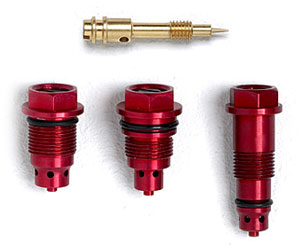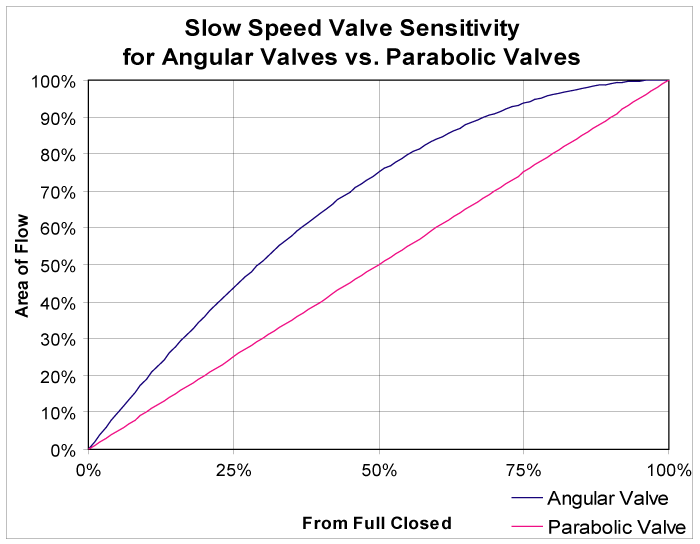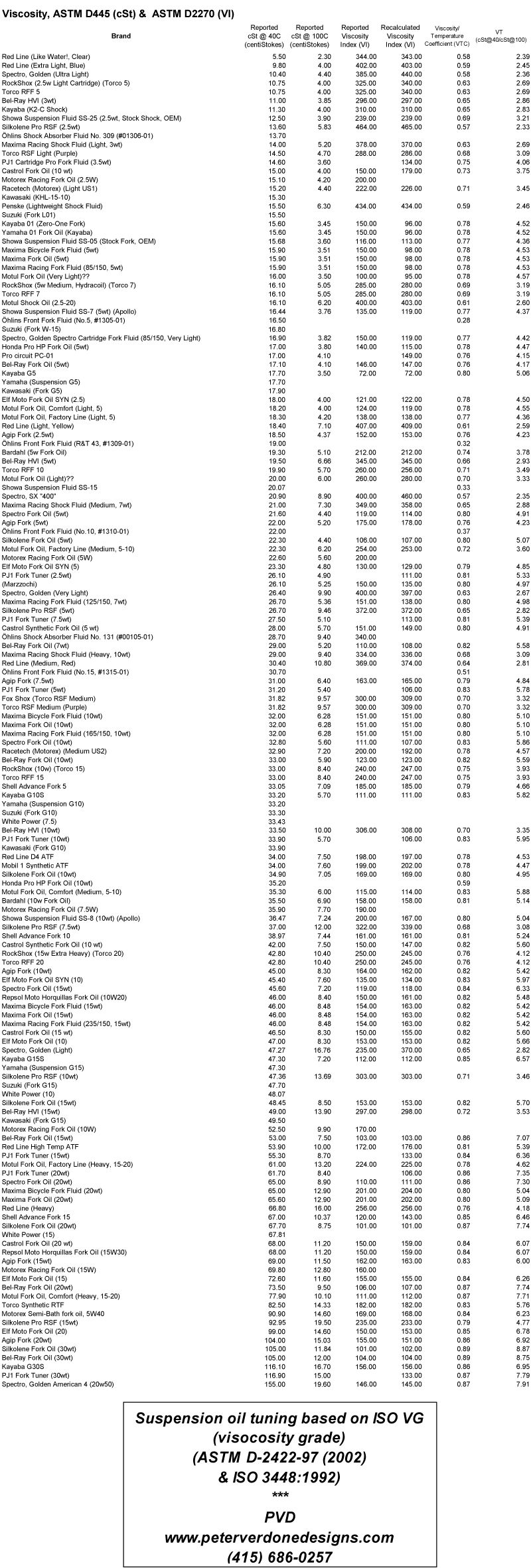
Low Speed Damping, Suspension Oils.
The oil in a bike's fork or shock not only cools and lubricates the system, but is the heart of all the damping control available for the springs. All phases of the damping involve the viscosity of the oil used in the system. Oil is such a critical suspension tuning decision that is the first priority to get worked out after spring/sag choice. No matter what all of your friends say about what the greatest high speed valves are or wild shim stacks, you should agonize over oil choice. In general, Use the least viscous oil possible that produces good slow speed damping performance with the damping adjustment screws out 1 full turn from full closed. This ensures that a fair amount of fine tuning will be available for track and weather conditions.
DO NOT GO BY LABLED OIL WEIGHT! Not only is this a poor way to decide which oil to use, but each manufacturer seems to be on a different scale. For example Maxima RSF 7wt is actually lighter than Spectro 5wt and Silkolene Pro RSF 7.5wt is actually heavier than Showa SS-8 10wt. This is not a judgment about the quality of these oils, just that the 'weight' label leads to a lot of trouble when trying to tune with suspension oils.
Suspension oil is labeled by weight because consumers are used to thinking of oil (ie. motor oil & gear oil) in these terms. The SAE weight system has a very broad and vague viscosity range and does not even cover the viscosity range that most quality motorcycle suspension systems require. Another point of confusion is that motor oils and gear oils are rated for viscosity on the SAE scale at different temperatures, leading to similar viscosity oils having very different ratings. SAE J300 is used to define engine oils, while SAE J306 is used to define drive line (gear) and chassis lubricants.
| SAE Motor Oil Grade | cSt @100C |
| 0W | - 3.8 |
| 5W | 3.8 - 4.1 |
| 10W | 4.1 - 5.6 |
| 15W | -5.6- |
| ##W-20 | 5.6 - 9.3 |
| ##W-30 | 9.3 - 12.5 |
| ##W-40 | 12.5 - 16.3 |
##W-50 |
16.3 - 21.9 |
| ##W-60 | 21.9 - 26.1 |
| SAE Gear Oil Grade | cSt @100 C |
| 70W | 4.1 + |
| 75W | 4.1 + |
| 80W | 7 + |
| 85W | 11 + |
90W |
13.5 - 24.5 |
| 140W | 24.0 - 41 |
| 250W | 41 + |
Some oils are labeled on the SUS / VI (ie. 85/150) or Saybolt Universal Second / Viscosity Index. Although this is slightly better system than using SAE 'weights', the Saybolt Universal Second is considered antiquated, is vague and is not a valid viscosity reference. ASTM D88-94(1999).
Modern fluid viscosity ratings are on an ISO VG (visocosity grade) (ASTM D-2422-97 (2002) & ISO 3448:1992) system of: cSt@40C / cSt@100C / VI. ‘cSt’ stands for CentiStokes, an accurate dynamic measure of viscosity (ISO 3104:1994 & ASTM D445-04). Using these numbers, you can tune oil viscosity with a very high degree of precision in a specific heat range. A straight line graph made from these two viscosity numbers at each temperature can give a very close approximation of the oils viscosity at any other usable temperature. A guide to ISO viscosity grades is HERE. A rough conversion table from SUS grades is HERE. A very, very rough conversion table from SAE gear and motor oil grades is HERE.

The Viscosity Index is very important in a suspension oil. “The viscosity index (V.I.) of an oil is a number that indicates the effect of temperature changes on the viscosity of the oil. A low V.I. signifies a relatively large change of viscosity with changes of temperature. In other words, the oil becomes extremely thin at high temperatures and extremely thick at low temperatures. On the other hand, a high V.I. signifies relatively little change in viscosity over a wide temperature range.” So specifically with regard to suspension, the greater the VI, the more consistent the damping will be over a large temp change.
The Viscosity Index is calculated as such:
VI = 100+(10^(LN((EXP(1.0727+0.6175*LN(cSt@100)+0.9744*(LN(cSt@100)^2)+(-0.3764)*(LN(cSt@100)^3)+0.04824*(LN(cSt@100)^4)))/cSt@40)/LN(cSt@100))-1)/0.00715
On a lovely Sunday morning, the ambient temperature may be 21C (70F). Motorcycle forks will run in the 26C (78F) temp range, rear shocks will run in the 65C (150F) range and rear reservoirs will be around 43C (110F). While motorcycle rear shocks require very high VIs (over 300) to function well over such a huge temperature range, motorcycle forks and bicycles do not. Anything over 100VI will be serviceable for them.
Some suspension oils are synthetic vs. mineral. These are very high quality oils and most general service applications do not require their use. You should, however, consider synthetic oil for performance applications. My Penske rear shock does require a full synthetic oil. Most oils on the market are either full mineral oil or a blend of mineral and synthetic oils. Almost all suspension oils will contain viscosity modifiers, seal conditioners, and anti-foam agents.
I suggest using either Silkolene Pro RSF (PDS)(ester) or Red Line (PDS)(polyol ester) synthetic suspension oils for front and rear suspension systems. They both have very high VI numbers and have enough of a viscosity selection to produce any mix you may need. You should, however, stay with one brand whichever way you go. I have decided to use Red Line exclusively. They range from extremely thin to extremely thick, in five different viscosities. They make the oil in nearby Benicia, CA and the oils come in really pretty colors.
Most cartridge type forks use a viscosity of 16 cSt@40C. (Except for Ohlins R&T, 19 cSt@40)
Most damper rod type forks use a viscosity of 34 cSt@40C. (Basically ATF Fluid)
Ohlins Steering damper use 16 cSt @40C for street and 19 cSt@40C for enduro and MX
Ohlins Shocks get set up with Öhlins Shock Absorber Fluid No. 309 (#01306-01) (13.7 cSt@40)
Penske Shocks get set up with Silkolene Pro RSF (5wt) (26.7 cSt@40)
| Viscosity, ASTM D445 (cSt) & ASTM D2270 (VI) | |||||||
| Brand | cSt @ 40C (centiStokes) |
cSt @ 100C (centiStokes) |
Viscosity Index (VI) |
cSt @ 21C (centiStokes) |
cSt @ 27C (centiStokes) |
cSt @ 43C (centiStokes) |
cSt @ 65C (centiStokes) |
Red Line (Like Water!, Clear) |
5.50 |
2.30 |
344.00 |
6.51 |
6.19 |
5.34 |
4.17 |
Red Line (Extra Light, Blue) |
9.80 |
4.00 |
402.00 |
11.64 |
11.06 |
9.51 |
7.38 |
Silkolene Pro RSF (2.5wt) |
13.60 |
5.83 |
464.00 |
16.06 |
15.28 |
13.21 |
10.36 |
Red Line (Light, Yellow) |
18.40 |
7.10 |
407.00 |
21.98 |
20.85 |
17.84 |
13.69 |
Silkolene Pro RSF (5wt) |
26.70 |
9.46 |
372.00 |
32.16 |
30.44 |
25.84 |
19.52 |
Red Line (Medium, Red) |
30.40 |
10.80 |
369.00 |
36.61 |
34.65 |
29.42 |
22.23 |
Silkolene Pro RSF (7.5wt) |
37.00 |
12.00 |
322.00 |
44.92 |
42.42 |
35.75 |
26.58 |
Silkolene Pro RSF (10wt) |
47.36 |
13.69 |
303.00 |
58.02 |
54.66 |
45.68 |
33.33 |
Red Line (Heavy) |
66.80 |
16.00 |
256.00 |
82.89 |
77.81 |
64.26 |
45.63 |
Silkolene Pro RSF (15wt) |
92.95 |
19.50 |
235.00 |
116.21 |
108.86 |
89.28 |
62.35 |
| Öhlins Shock Absorber Fluid No. 309 (#01306-01) | 13.7 |
||||||
Öhlins Front Fork Fluid (New) |
? |
||||||
| Öhlins Front Fork Fluid (No.5, #1305-01) | 16.5 |
||||||
| Öhlins Front Fork Fluid (R&T 43, #1309-01) |
19 |
||||||
| Öhlins Front Fork Fluid (No.10, #1310-01) | 22 |
||||||
| Öhlins Shock Absorber Fluid No. 131 (#00105-01) | 28.7 |
9.4 |
|||||
| Öhlins Front Fork Fluid (No.15, #1315-01) | 30.7 |
||||||
I have prepared mix charts for Red Line or Silkolene oil. Follow the links. Suspension fluid must be changed often for optimum performance. Rear shock oil suffers from thermal breakdown due to the extreme temperatures that they operate in and shear forces under high load (hydrocracking). The fork does not suffer from this but does suffer from massive amounts of contamination from inside and outside.One more very important point must be made when talking about oil tuning. While tires may take around 10 minutes to reach their full running temperature, the rear shock on a motorcycle can take upwards of 30 minutes to fully heat up. This being the case, you should not attempt to change any settings in the suspension or make any decisions on which direction to go with oil viscosity until the bike has been ridden hard for at least 30 minutes.
Low Speed Damping, Orifice Valves
98% of the riding time on a bike is spent in the slow speed damping circuit. Where a tuner will see the greatest change in damping control is with a change in oil viscosity on the slow speed circuit. The slow speed damping circuit is controlled by the slow speed orifice size and oil viscosity. This circuit follows a quadratic damping curve. As the velocity of the unit goes up, the damping force goes up by the square of the velocity. Some riders will describe this as 'ramping up'. On a damper rod type fork, this force will grow until the fork reaches a state called 'hydraulic lock'. On a cartridge fork, at some damping force, defined by the shim stack and HS valve, the high speed valve takes over and follows a new curve defined by the shim stack. This keeps the fork moving even at very high velocities. This is a picture of are of the ultra high end K-tech Angular Slow Speed Compression Adjusters and GP Suspension needles.


Traditional cone type orifice valve adjustment has a tricky usability problem. Changes made early in the range account for most of the adjustment, while almost nothing is gained at the end of the range. From the graph below, it is easy to see that a valve with a parabolic shape is far more desirable than one with a simple cone shape. The radius of the cone travels on a y=m*x curve and the parabola follows a y=x^(1/2) curve. When the area displaced by the valve is computed, A=PI*R^2, the rate of change squares on the cone, while the parabolic valve is liniarized. Much easier to make changes with for sure. 
Here is a helpful index of most of the commercially available suspension oils that provide useable data.

This site has not been
updated since Fall 2006.
Since then, all new projects
have been place on my wiki
site.
If you like what you see on
this site, Make sure to go
to the wiki for even better
projects.